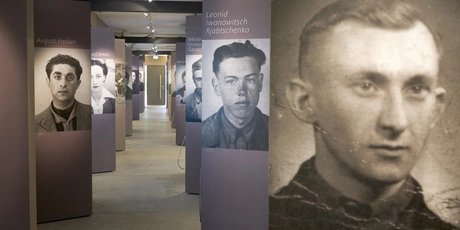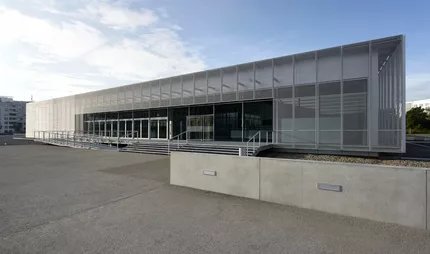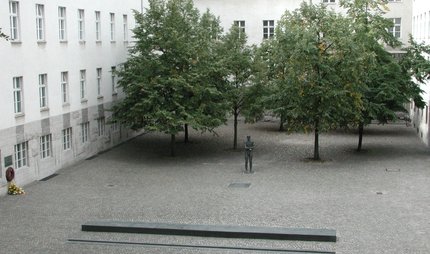
Nazi Forced Labour Documentation Centre
Memorial to the Former Forced Labour Camp in Schöneweide
The Nazi Forced Labour Documentation Centre tells the stories of the people who were imprisoned there. The Centre is housed in a former Nazi labour camp.
The documentation centre is part of the Topography of Terror Foundation which also operates as its educational and archive site. The Documentation Centre in Niederschöneweide is on the site of a former Nazi camp for forced labour, one of more than 3,000 similar camps which once stood in the Berlin area. Entering the exhibition spaces, you will find inscriptions on the walls, letters and biographies which all provide a very personal insight into the prisoners' lives. Down in the air-raid shelter behind the thick walls, you have a chance to learn about the daily lives of the people detained in the camp.

Tour of the barracks
During the National Socialist era, up to 13 million people were imprisoned in the labour camps of the Third Reich. These people came from many countries including Belgium, Italy and the Soviet Union. Only one of the 3,000 camps in the Berlin area still exists today - as the Dokumentationszentrum NS-Zwangsarbeit in the Schöneweide area of the city - to provide an important link to the past. In 2006, the camp opens to the public under the direction of the Topography of Terror Foundation. In 2010, guided tours of the best-preserved of the camp's buildings, Barrack 13, begin. Barrack 13 also has an intact air-raid shelter with inscriptions scrawled on the walls by Italian prisoners of war.

Barrack 2 contains information about the everyday lives of people in the forced labour camp. Biographies, photographs and written documents bring their destiny into sharp focus and gives a true impression of their harsh living and working conditions.The story is one of fear and oppression, but also of freedom and the will to live. The permanent exhibition called "Caught Between Two Worlds" is housed in Barrack 4. This tells the story of the 650,000 Italians deported to Germany during the Nazi regime. One of the most striking exhibits is the pocket calendar of Italian Capitan Mario Zipolini, which details his arrest in France. Work your way clockwise round six different thematic areas, a tour which will take around an hour and which takes you out into the surrounding streets and to the banks of the river. Touchscreens are available to help visitors access audio and video clips.
Highlights of the Dokumentationszentrum NS-Zwangsarbeit
- As part of guided tours: true to original barrack 13 with air-raid shelter
- Names and dates written on the walls by Italian prisoners of war
- Exhibition about everyday life in the camp with photographs and written information
- Information about how large German companies participated in the forced labour programme, such as Lufthansa trademarks
- Multimedia maps showing the routes people took when deported to the labour camps
Holocaust memorials in Berlin
The victims of the Holocaust have not been forgotten. Numerous Holocaust memorials in Berlin commemorate the victims of National Socialism. With its 19,000-square-meter field of stelae, the Memorial to the Murdered Jews of Europe conveys an impression of the horrific scale of the Nazi horror regime. Not far from it in the Tiergarten are two other important memorials, the Memorial to the Homosexuals Persecuted during the Naziera and the Memorial to the Sinti and Roma of Europe Murdered under National Socialism.
History in Berlin's Schöneweide district
Just a 15 minute walk from the Documentation Centre is the Industry Museum where you can see tools and exhibits mainly from the GDR era. These include electrical tubes made for televisions by the VEB factory and the first microwave oven made in the GDR. The Rathenau building in Oberschöneweide is undergoing rapid development and is already home to studios, galleries, a restaurant and function rooms. The building is just across the river Spree from the Dokumentationszentrum NS-Zwangsarbeit.
Tips for your visit
Berlin-Schöneweide is the nearest station and is served by the S8, S9, S45, S46, S47 and S85 S-Bahn lines. Alternatively, take the 165 bus directly to the museum entrance. Every first and third Sunday at 3 pm there will be a free guided tour of the grounds and Barrack 13. Entrance to all areas is free, and you can download the history workshop app on your smartphone.
On the website "1945: At an end but not over" the Documentation Centre documents temporary witness accounts, extracts from diaries, letters, and memories from the Berlin area.
Opening hours
| Tuesday | |
|---|---|
| Wednesday | |
| Thursday | |
| Friday | |
| Saturday | |
| Sunday |



